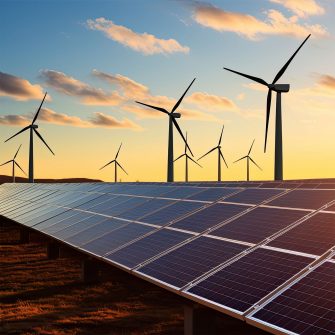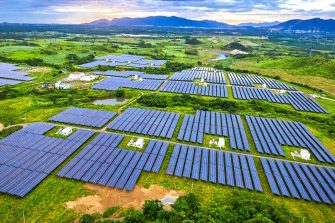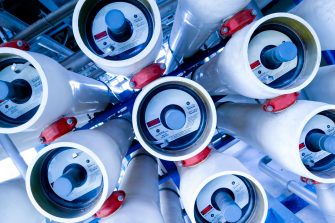Guiding the transition to 100% renewable energy
Understanding and informing clean energy transition for today and tomorrow.

Share this story
Through modelling, analysis and integration of renewable energy and distributed energy resources – the work of Associate Professor Anna Bruce, of the UNSW School of Photovoltaic and Renewable Energy Engineering and the Collaboration on Energy and Environmental Markets (CEEM), is informing the transition to clean energy both locally and abroad.
Credit: Shutterstock
While this research includes a variety of challenges and opportunities, it allows A/Prof. Bruce and her team to assist stakeholders within the national electricity market and other similar market-based electricity industries.
”We bring an interdisciplinary lens into the energy transition problem to understand the technical aspects of integration of large-scale renewables into the electricity industry, and also distributed energy resources like rooftop solar, batteries and smart loads, and how those things work together."
- A/Prof. Bruce
In combining the large and small scale, the team look at the electricity industries transitioning to 100 per cent renewable energy as well as how other energy sectors can be brought into the electricity industry to also become renewable. “We analyse the impacts of new technologies to understand and characterise them in our technical work and modelling,” she explains.
“We look at what they might do under different future market arrangements or in a future where we have a mix of different technologies and ways of controlling them.”
- A/Prof. Bruce
This work enables A/Prof. Bruce and her team to better understand the technical impacts as well as the outcomes under different business models and regulatory approaches.
Through the development of software tools for analysis and modelling, CEEM also create packages that can be used by different stakeholders to help them understand what’s occurring in particular locations, and any potential future changes. “This helps stakeholders participate in public discussions and consultations and allows them to have informed input into decisions,” adds A/Prof. Bruce.
Putting power back in consumer hands
Throughout the last 10 years, A/Prof. Bruce, along with Mike Roberts and the team have been busy working on their SunSPOT tool, which supports Australian households, small businesses and councils in making more informed decisions about solar and batteries.
This free online tool, currently funded by the Australian Federal Government, uses geographical information systems data collected from plane flyovers, to model the tilt orientation of any rooftop and the shading from surrounding trees and buildings to accurately estimate the output of solar. This information then allows consumers to make better decisions about how much solar they might consume, how much they would export to the grid, and how a battery might help to increase use of that solar on site. “It also helps them work out all the bills under different tariffs to understand the implications of different options in terms of getting solar and batteries,” says A/Prof. Bruce.
A/Prof. Bruce working on the development of the SunSPOT online tool.
As at 1/1/2024, more than one in three houses in Australia have rooftop solar.
Energy resilience in the future grid
Further to the SunSPOT project, the CEEM team, led by Naomi Stringer, has been busy working on Project MATCH which looks at how distributed energy resources, particularly rooftop solar, behaves during system disturbances.
“The project looks at events like blackouts and how the distributed PV is behaving, to what extent that presents a risk to the future security of the electricity industry, and how we should manage those risks.”
- A/Prof. Bruce
Industry partners within this project include the Australian Energy Market Operator (AEMO) and Solar Analytics – as well as numerous other stakeholders who provide necessary data and additional perspectives.
As part of this project, the team are building tools to automate analysis of data and extract information to model outcomes under different future scenarios to help inform decision making. AEMO is already using insights from this project to develop internal tools to better understand the behaviour of distributed solar during extreme events.
Heading to the Pacific
Led by CEEM’s Prof. Iain MacGill with PhD candidate Janendra Prasad, the team have also been working closely with leaders and stakeholders within the Pacific Island countries, helping them transition to renewable energy and reduce their emissions, while also developing tools they can use to help build their capabilities within various planning processes. “It’s really important for them because they’re facing existential threat from climate change and they want to demonstrate their commitment and leadership in international climate change negotiations,” explains A/Prof. Bruce. “It’s really challenging though because many of these countries are very small and don’t have a lot of diversity in their grids in terms of their electricity resources.”
These issues are further bolstered by the remote locations and marine environments of many of these countries, and low electricity access. “There are lots of people that still don’t have access to electricity of adequate quantity and reliability,” adds A/Prof Bruce. “We’ve made a lot of efforts to help them by providing the tools and capacity to really undertake that planning and assess proposals from businesses who want to develop projects.”
Although there are numerous challenges to transitioning from a system based on centralised fossil fuel generators to weather-dependant, renewable energy generators – the research undertaken by CEEM, including A/Prof. Bruce and her team aims to not only understand these challenges but provide solutions that are effective, flexible and future-proofed.
UNSW fieldwork with off-grid PV systems for remote Fijian communities in 2023.
Share this story
Read more
Get in touch and see what’s possible.
Ask how we can help your business, industry or market through collaboration.



